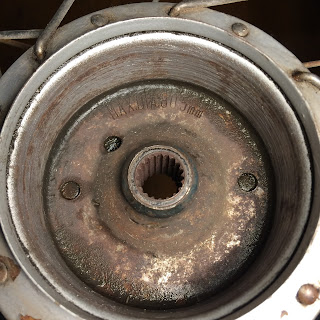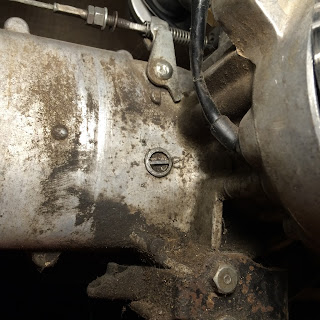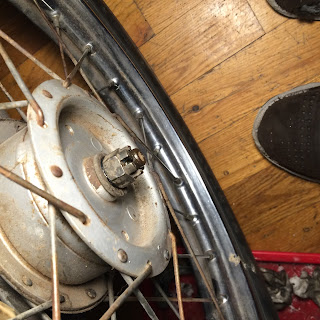It smells like gas at my kitchen table, not the fart kind. I blame the carb in pieces next to me.
Since the last episode, I sorted the wiring harness a little bit, adjusted the points and replaced the gas tank. I bought a motorized bicycle tank from my buddy Greg and strapped it to the main tube in the front. I ditched the old tank because of the chronic pinholes and the patches I made with the JB weld were going loose. I probably could have used some tank sealer in addition to the JB weld and had a leak free tank, but I don’t really know what kind is good and it’s easier to just slap this rust/leak free tank on and be done with it. It also makes the bike look a bit better without that rack on the back. I moved the tail light to under the seat and the bike looks a bit more like a bobber or something.
I also had to put on a new spark plug boot because some shit clown cut the old one off the scooter while it was locked up. I cannot even. It had been chewed up by my old roommates cat and was covered in electrical tape to minimize shocks. It would still get you sometimes even with the tape. It was crap and someone stole it, I can't figure out why. I bought it new for I think $3. It makes my head hurt. Whatever. The new one is an upgrade. I hope no one swipes that one and if they do, I hope they have the decency to not cut the wire on my coil any shorter because I don't think I can easily replace it.
The big news is that I got it to run, very badly, but it runs. I even rode it around the block, twice! It runs really erratically and revs up real high sometimes without throttle input and then other times it doesn’t even want to idle and will just die without blipping the throttle. It also seems to bog down at full throttle. I’m pretty sure I could outrun it at full throttle. I’ve been trying to figure it out and I think it might be “four stroking” where it’s not firing every other stroke, but skipping an extra cycle in between. I guess adjusting the mixture is supposed to fix that. I didn’t find a good explanation as to how to do it though. More research on that is needed.
I saw a youtube video of someone pulling out the idle jet tube to clean out some holes at the top. I carefully got mine out with a pair on some pliers. It doesn’t have any holes at the top in the side of the idle jet tube when you pull it out with pliers, unlike the video. Supposedly if these holes are a common clog/clean/fix situation, but it’s not the case for me. Pulling it out is going to let me get it extra clean though. I’d love to pull out the main jet and clean it, but I can’t seem to figure out how to press out the main jet. I might go grab some pipe cleaners and see if those help.
I have a carb rebuild kit that I bought from treats and it seems to have extra parts and maybe not have an exact fit. It seems like the Honda Expresses had a different carb every other year and even different carbs for the same year. It’s a third party (non-OEM) kit so we’ll see how it goes. It had fun 80’s-tastic packaging though so I’m pretty optimistic.
The carb on my 1980 Honda express NC50 says “PA08BBRI” and then has some marks that look like the Atari symbol but missing some lines. I found a page on Myrons Mopeds that seems to have some relevant info.
Float needle valves are different between P08BA and P08BB. I might have the wrong one in there. Honda part no. 16155-883-005 is the one I’m supposed to have in there according to myrons mopeds. I have something in there that looks more like the other one for the P08BA carb, honda part 16011-881-741, called the stirrup version, as opposed to the regular one in the PA08BB. I don’t know if it really makes a difference though. The rebuild kit came with one that looks like the right one for my carb.
It also looks like I’m supposed to have a different float. I have a black plastic one in there now but I guess I’m supposed to have a yellow hollow plastic one in there. I wonder if the float and float needle valves go together. Hmmm.
(Carb part info source: http://www.myronsmopeds.com/2015/01/other-moped-carburetors/)















